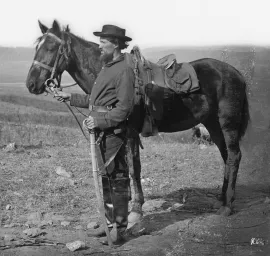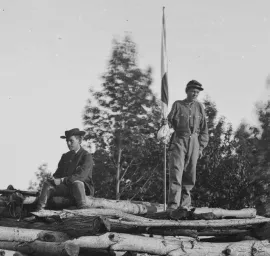
Today's United States Army is an evolution of George Washington's Continental Army of 1775. There are essential elements of the American military experience that can be identified and tracked over centuries of change. Please use this article to expand your knowledge of the lives of American soldiers throughout history.
What They Ate

Soldiers in Washington's army were supposed to receive a daily ration of beef, rice, peas, flour, milk, and spruce beer. The states, however, struggled mightily to sustain their men, leading to frequent periods of extreme scarcity. Salt, primarily provided by foreign sources, was quite rare, so meat was usually not stored and stockpiled. George Washington's mess kit is depicted here. (Smithsonian Institution)

"Sutlers" were licensed merchants who sold staples and luxury items in camp during the Revolutionary War and the Civil War. They were able to fulfill some of the soldiers' needs that were unmet by more official services. Sutlers and soldiers relied on each other but frequently felt wronged by the other party--sutlers often inflated prices and soldiers were often unwilling or unable to pay their debts. This entrepreneur built a "Fruit & Oyster House" near the Union siege trenches at Petersburg, Virginia in 1864. (Library of Congress)

During the Civil War, advancements in food storage were made manifest in these boxes of stiff, chalky “hardtack” biscuits (known to soldiers as “teeth-dullers,” “sheet-iron crackers,” or “worm-castles”) and dehydrated vegetable sheets known commonly as “desecrated vegetables.” (Library of Congress)

During the Spanish-American War, hard tack was stamped with the rallying cry "Remember the Maine." (Image courtesy of Bexley Historical Society Museum)

In 1895, sutlers were replaced by official Army "Post Exchanges," commonly abbreviated as PX. This arrangement persists to the present day. (Library of Congress)

Sustaining the hardtack tradition, the Army continued to research and develop new methods of optimizing food to meet nutritional as well as logistical needs. (Library of Congress)

The "K Ration," among others, was designed to nourish soldiers when kitchen facilities were unavailable. Some Second World War veterans remember subsisting on K Rations for weeks at a time. (Library of Congress)

In today's Army, continued technological development has resulted in the MRE (Meal Ready to Eat). Some rations have also been enhanced for military purposes, such as the Hooah!/Oorah! energy bar. (Image courtesy of Wikimedia Commons)
How They Fought

Revolutionary War battles were characterized by tightly packed formations and massed assaults. Inaccurate, slow-to-reload smoothbore muskets and cannons meant that a determined charge could break an enemy line before the enemy's firepower could stop the attackers. American guerrilla fighters also found success with loose formations and hit-and-run tactics in areas where the terrain offered cover and concealment. (National Guard Heritage Collection)

By the time of the Civil War, the development of rifled gun barrels had drastically improved the range and accuracy of infantry weapons and cannons. Soldiers were expected to be able to fire a musket three times per minute or a cannon (with a full crew) twice per minute. (Library of Congress)

Civil War generals, still coming to grips with the new technology, continued to fight in the Revolutionary style with minor variations. Although large assaults were still sometimes successful, extraordinarily bloody experiences at Fredericksburg, Gettysburg, Vicksburg, Cold Harbor, Petersburg, and elsewhere indicated that the old strategies would not be able to keep up with the advancements in weaponry. (Library of Congress)

Couriers, soldiers who hurried around the field delivering written and spoken orders on behalf of commanding officers, were the primary mode of battlefield communicatields. They saved valuable time that a courier would have needed to ride or run from place to place. (Library of Congress)

Signal towers, populated by soldiers waving flags to communicate in code, were sometimes used on Civil War battlefields. They saved valuable time that a courier would have needed to ride or run from place to place. (Library of Congress)

Hot-air observation balloons were used in a limited capacity during the Civil War, though they were eventually abandoned. The heavy black powder smoke discharged by muskets and cannons rendered aerial observation largely ineffective. (Library of Congress)

Military technology reached a turning point in the First World War, which saw widespread use of machine guns, poison gas, and indirect artillery fire. Massed formations and desperate charges were decisively outmatched by the new weaponry, with bloody results. World War I was the first war in which American soldiers were issued steel combat helmets, a precursor to the elaborate body armor that exists today. (National Guard Heritage Collection)

Aircraft allowed commanders to perform reconnaissance from the clouds. The development of smokeless gunpowder around the turn of the 20th century solved the problems faced by Civil War balloonists. Many aerial "dogfights" were driven by competition for prime observation areas. (National Guard Heritage Collection)

The mass production of tanks during the Second World War was a death knell for the linear fighting formations that had for so long constrained battlefield tactics. The steel beasts could break through a firing line with ease, but dispersed and hidden infantrymen could destroy an unwary tank with a variety of armor-piercing weaponry. (National Guard Heritage Collection)

Radios and field telephones revolutionized battlefield communication during the World Wars. Though no longer the norm, couriers were and are still used if the circumstances require them. (Image courtesy of Wikimedia Commons)

Modern infantry weapons have taken another big leap in accuracy and power. Today's M16A2 assault rifle is able to effectively engage at ranges up to 800 yards, whereas a Civil War rifled musket had an effective range of less than 200 yards. (Image courtesy of Wikimedia Commons)

Today's body armor is the product of extensive research and development. A full set weighs more than thirty pounds. Steel helmets have been replaced by other materials that are more resistant to the concussive effects of explosions. (Image courtesy of Wikimedia Commons)

Unmanned aircraft have combat capabilities, but they are most often employed in reconnaissance roles in conjunction with infrared and other imaging technologies. (Image courtesy of Wikimedia Commons)
Modern American soldiers eat, live, and fight in ways that have been foreshadowed and guided by the unique problems and solutions of their historical counterparts. This has been only a very brief overview of the challenges and accomplishments of the American military system.





